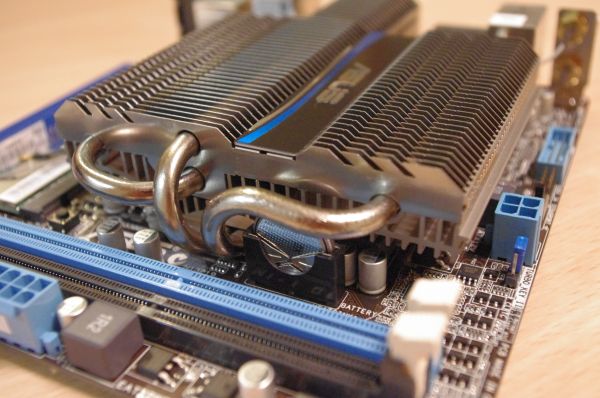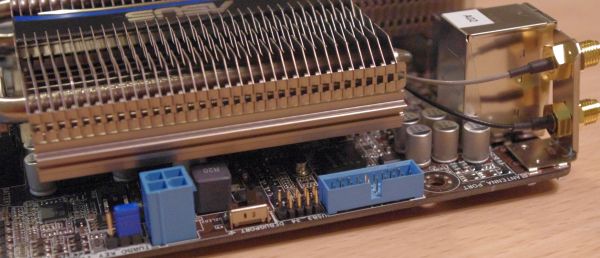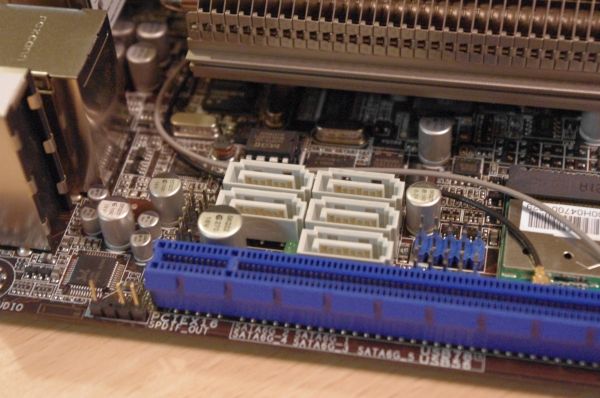Fusion E-350 Review: ASUS E35M1-I Deluxe, ECS HDC-I and Zotac FUSION350-A-E
by Ian Cutress on July 14, 2011 11:00 AM ESTEver since I first tinkered around with the ASUS board, I had a love/hate relationship with it. It's a prime example of what a lot of people may want in a board - it's passive, the wifi is already built in (you just fix the antenna), and it runs straight out of the box. But the more I prodded around the vibrant exterior, I tried to find what I would get for my $175, especially compared to the other boards I have here for review.
Despite the E-350 processor on board, the passive heatsink gets incredibly hot to touch, even at idle in a fanless environment. The CPU itself is rated at 18W, and without a discrete GPU, the board is pulling around 60W in our stringent tests. This is disconcerting, considering that the ECS board (even though it isn't passive) pulls off a 33% overclock. Also, due to the size passive heatsink, the IO panel is hit - the onboard audio has only two outputs and we're limited to DVI and HDMI video. This doesn't happen on the Zotac board, which is also passive.
Visual Inspection
I've mentioned it before and I'll mention it again - heatsink. This motherboard has a massive one, with ASUS on it, just in case you forgot. The heatsink is still shorter than any full height DDR3 memory you put in the DIMM slots, and there are two fan headers found in the top left, just beside the heatsink in that corner.
There is a USB 3.0 header along the top of the board, along with a debug header, a Turbo switch, a 4-pin 12 V CPU connector and the Clear CMOS header. Unfortunately, the writing next to these is all mixed up - the writing above the turbo switch says 'DEBUG PORT' and above the Clear CMOS is 'TURBO_KEY+II'. Nowhere on the board does it say the Clear CMOS is the Clear CMOS - during bad overclocking I had to refer to the manual to find this information.
Thankfully, the front panel connectors are still on the right hand side of the DDR3 DIMM slots (unlike the ECS), and the wifi card is preinstalled in a very tight space the other side of the DIMMs. The five SATA 6 Gbps ports are also here, with USB 2.0 headers, and the MEM OK button which is ASUS' memory adaptation feature if there is incompatibility with any memory module changes. The HD Audio header is on the far left of these headers and ports, which could cause an issue depending on where the cable is coming from and what's installed on the board. There is also a full length PCIe slot - it will accept any 16x peripheral, but run it at 4x speeds, including discrete GPUs.
The I/O panel is a mixture of positive and negative. Because of the large heatsink impinging into the panel, some of the functionality is lost. Alongside the two antenna ports, we have a single PS/2 port, four USB 2.0 ports, two USB 3.0 ports, HDMI (1.3b) and DVI video outputs, optical S/PDIF Out, a Bluetooth receiver, an eSATA 6 Gbps port, an Ethernet port and three audio jacks. The big surprise here is that the HDMI is only 1.3b and not 1.4a...




















67 Comments
View All Comments
mschira - Friday, July 15, 2011 - link
I find it hard to believe how calmly the praises for the 33% overclock are. Just face it the Lano platform can use all the speed it can get, and that 33% sounds healthy enough.At 1.6 I think Lano is slightly underpowered, at 2.1Ghz, well slightly less i.e. not anymore.
It hard to understand why AMD isn't coming up with a 2Ghz variant of Lano. I fact I find it very concerning. It looks as if AMD is just not determined enough to compete with Intel.
M.
Rick83 - Friday, July 15, 2011 - link
E350 is not Llano.And mini ITX E350 is not meant for overclocking and performance.
Thus I find this to be a bit of a non-feature. Better to get a passively cooled 32nm Intel S1156 Pentium, if you need more performance.
As far as I know, the only drawback this level of performance has, is when flash movies at extreme settings are played. While this may be important for some, it's not needed in a general browsing/mail machine that does the odd office application. Nor in most home cinemas, where local mkvs or disks are played.
Yet for this overclock you give up on passive cooling and instead get a tiny, and presumably relatively whiny fan. Not worth the hassle.
AmdInside - Friday, July 15, 2011 - link
I have an older ITX case I would like to continue using and it puzzles me why almost all of these mobos use a 24-pin connector when there are so many ITX cases with a 20-pin connector.andymcca - Friday, July 15, 2011 - link
Does anyone spend money on WHS for NAS? Seems like a waste. (Don't get me wrong, I see some reasons to get it if text scares you and you are doing something more complicated. And have money to burn. Or live on a pirate ship.)RAID is supported in the Linux kernel, and is better than any junky fakeRAID a motherboard might provide. And with 6 SATA 6Gb/s ports, this makes a damn fine NAS!
andymcca - Friday, July 15, 2011 - link
Though the lack of 1000 Gb/s ethernet is sad :(andymcca - Friday, July 15, 2011 - link
I'd settle for 1Gb/s :)Rick83 - Friday, July 15, 2011 - link
which all of these boards have.burpnrun - Friday, July 15, 2011 - link
Firstly, the author starts by positioning the AMD CPU/boards in a HTPC context. Then promply forgets any consideration of a HTPC role. Not one video/encoding/decoding/transcoding benchmark. Instead, "games" and "computational" benchmarks. WTF? I'm wondering, is this guy competent?Secondly, as other posters have commented, the author's/article's power consumption measurements are so outlandish as to be laughed at. I mean, seriously warped versus reality. Incompetence (and determined reluctance to remeasure/fix) is brashly showing through at this point.
The coup-de-gace of this idiotic review, though, is the inclusion of a Nvidia 580GTX for games, a role the Brazos CPU/Chipsets are not positioned towards. A 580GTX? In a 4x PCIe slot? And there are problems? WOW. I wonder why? At this point I concluded that not only was the author totally incompetent, but the motive of the article was also highly suspect.
Until Arnand cleans up this stinking pile of pseudo "review", I'm not coming back here. I'm not a Intel or AMD fanboy, but this is such an incompetent, biased, purposeless (or was there a mission here that tried to be masked by "review" status?) article that a line has to be drawn in the sand against outright c*rap "reviews" like this.
Anand, you should be ashamed to even have this piece of junk on your site!
ET - Friday, July 15, 2011 - link
If this is the worst review you've read in 15 years, uou must not read a lot of reviews, so your threat of not coming back probably means that the next review you'll read in five years will be on another site. If you really want, I can point you to a lot of other sites with worse reviews.Not saying that this review is perfect, but come on, lots of other reviews of the E-350 have done exactly the same things, and some of your issues are nit-picking. Would you had been happier if a lower end discrete card was put in the PCIe slot? Putting a very high end one just illustrates how CPU bound this platform is.
AnandThenMan - Friday, July 15, 2011 - link
"lots of other reviews of the E-350 have done exactly the same things"Post the links, I'd like to read them. Thanks.